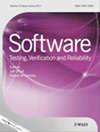In vivo testing and integration of proving and testing
IF 1.2
4区 计算机科学
Q3 COMPUTER SCIENCE, SOFTWARE ENGINEERING
引用次数: 0
Abstract
In this issue, we are pleased to present two papers, one for in vivo testing and the other for integration of proving and testing. The first paper, ‘In vivo test and rollback of Java applications as they are’ by Antonia Bertolino, Guglielmo De Angelis, Breno Miranda and Paolo Tonella, presents the Groucho approach for in vivo testing, a specific kind of field software testing where testing activities are launched directly in the production environment during actual end-user sessions. The Groucho approach conducts in vivo testing of Java applications transparently, not necessarily requiring any source code modification nor even source code availability. Being an unobtrusive field testing framework, Groucho adopts a fully automated ‘test and rollback’ strategy. The empirical evaluations of Groucho show that its performance overhead can be kept to a negligible level by activating in vivo testing with low probability, along with showing the existence of faults that are unlikely exposed in-house and become easy to expose in the field and showing the quantified coverage increase gained when in vivo testing is added to complement in house testing. (Recommended by Xiaoyin Wang). The second paper, ‘A failed proof can yield a useful test’ by Li Huang and Bertrand Meyer, presents the Proof2Test tool, which takes advantage of the rich information that some automatic provers internally collect about the programme when attempting a proof. When the proof fails, Proof2Test uses the counterexample generated by the prover to produce a failed test, which provides the programmer with immediately exploitable information to correct the programme. The key assumption behind Proof2Test is that programme proofs (static) and programme tests (dynamic) are complementary rather than exclusive: proofs bring the absolute certainties that tests lack but are abstract and hard to get right; tests cannot guarantee correctness but, when they fail, bring the concreteness of counterexamples, immediately understandable to the programmer. (Recommended by Marcelo d'Amorim). We hope that these papers will inspire further research in related directions.体内测试及验证与测试的整合
在这一期,我们很高兴提供两篇论文,一篇是关于体内测试,另一篇是关于证明和测试的整合。第一篇论文,“Java应用程序的体内测试和回滚”,作者是Antonia Bertolino, Guglielmo De Angelis, Breno Miranda和Paolo Tonella,介绍了Groucho的体内测试方法,这是一种特定的现场软件测试,在实际的最终用户会话期间,测试活动直接在生产环境中启动。Groucho方法透明地进行Java应用程序的活体测试,不一定需要任何源代码修改,甚至不需要源代码可用性。作为一个不引人注目的现场测试框架,Groucho采用了完全自动化的“测试和回滚”策略。对Groucho的实证评估表明,通过以低概率激活体内测试,同时显示不太可能在内部暴露但在现场容易暴露的故障的存在,以及显示添加体内测试以补充室内测试时获得的量化覆盖率增加,可以将其性能开销保持在可忽略的水平。(推荐人:王小银)第二篇论文,“一个失败的证明可以产生一个有用的测试”,由Li Huang和Bertrand Meyer提出了Proof2Test工具,它利用了一些自动证明者在尝试证明时内部收集的关于程序的丰富信息。当证明失败时,Proof2Test使用由证明者生成的反例来生成失败的测试,这为程序员提供了立即可利用的信息来纠正程序。Proof2Test背后的关键假设是,程序证明(静态)和程序测试(动态)是互补的,而不是排斥的:证明带来了测试所缺乏的绝对确定性,但证明是抽象的,很难正确;测试不能保证正确性,但是,当测试失败时,会给程序员带来反例的具体性,让他们立即理解。(Marcelo d’amorim推荐)。我们希望这些论文能够启发相关方向的进一步研究。
本文章由计算机程序翻译,如有差异,请以英文原文为准。
求助全文
约1分钟内获得全文
求助全文
来源期刊

Software Testing Verification & Reliability
工程技术-计算机:软件工程
CiteScore
3.70
自引率
0.00%
发文量
34
审稿时长
>12 weeks
期刊介绍:
The journal is the premier outlet for research results on the subjects of testing, verification and reliability. Readers will find useful research on issues pertaining to building better software and evaluating it.
The journal is unique in its emphasis on theoretical foundations and applications to real-world software development. The balance of theory, empirical work, and practical applications provide readers with better techniques for testing, verifying and improving the reliability of software.
The journal targets researchers, practitioners, educators and students that have a vested interest in results generated by high-quality testing, verification and reliability modeling and evaluation of software. Topics of special interest include, but are not limited to:
-New criteria for software testing and verification
-Application of existing software testing and verification techniques to new types of software, including web applications, web services, embedded software, aspect-oriented software, and software architectures
-Model based testing
-Formal verification techniques such as model-checking
-Comparison of testing and verification techniques
-Measurement of and metrics for testing, verification and reliability
-Industrial experience with cutting edge techniques
-Descriptions and evaluations of commercial and open-source software testing tools
-Reliability modeling, measurement and application
-Testing and verification of software security
-Automated test data generation
-Process issues and methods
-Non-functional testing
 求助内容:
求助内容: 应助结果提醒方式:
应助结果提醒方式:


